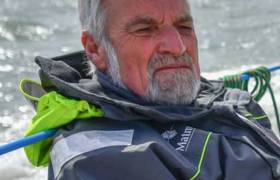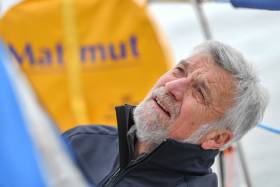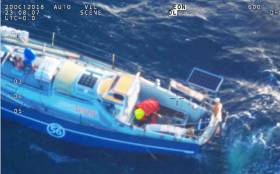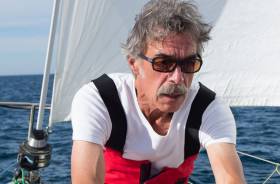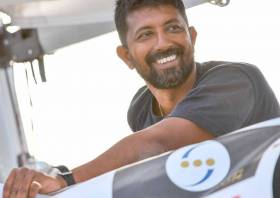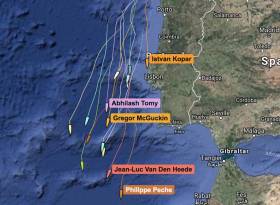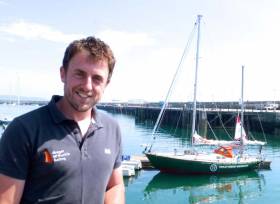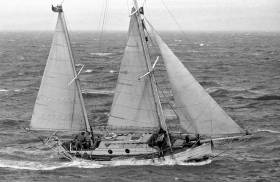Displaying items by tag: Golden Globe Race
Golden Globe Race: Susie Goodall Dismasted 2,000 Miles West of Cape Horn
British yachtswoman Susie Goodall was pitchpoled and dismasted in the Southern Ocean some 2,000 miles west of Cape Horn today. A distress signal was first picked up from her yacht by Falmouth Coastguard at 11:00 UTC, who then alerted Race Control and the Chilean Maritime Search and Rescue authorities responsible for this sector of the South Pacific.
Goodall, (29) from Falmouth UK, and the youngest competitor in the Golden Globe Race, was lying in 4th place at the time, riding out a ferocious storm with 60-knot winds and massive seas aboard her Rustler 36 yacht DHL Starlight.
Susie Goodall's position 2,000 miles West of Cape Horn when the storm struck, and those of her nearest rivals in this solo non-stop round the world race.
In her last text message to Race Control received before the dismastig at 08:29 UTC,, she reported' TAKING A HAMMERING! WONDERING WHAT ON EARTH I'M DOING OUT HERE
In a subsequent message, received at 12:23 UTC, she wrote: DISMASTED. HULL OK. NO FORM OF JURY RIG, TOTAL LOSS Position: 45' 27.787 S 122' 23.537 W.
After 3 attempts, Race HQ was able to raise Goodall on her emergency satellite phone when she confirmed: "I have been dismasted. Thought I had holed the hull because the boat filled with water, but the hull is NOT holed. The hull is OK.
The boat is destroyed. I can't make up a jury rig. The only thing left is the hull and deck which remain intact.
We were pitchpoled [rolled end over end] and I was thrown across the cabin and knocked out for a while. "
Speaking with emotion, but sounding very much in control of her situation, Susie also confirmed that she had secured all hatches, portholes and safety equipment, and did NOT need immediate assistance. She said that before the incident, she had been enjoying the conditions and felt in control. But then the safety tube on her Monitor self-steering broke and she was forced to trail a drogue anchor astern and take down the mainsail. She was below decks when the boat was pitchpoled, and when she returned on deck to assess the damage, found that the line attached to the drogue had parted.
Susie also reported that she 'has been beaten up and badly bruised' with cuts and scratches and a big bump on her head. MSOS, the GGR's 24 hour medical telecentre has been advised and doctors are now monitoring her symptons and providing direct medical advice
The winds have since dropped down to 45 knots and conditions are likely to improve further as the storm continues to head East.
The nearest GGR competitor is Estonion Uku Randmaa 400 miles ahead of Goodall and about to face the same storm conditions, so it is impractical for him to turn about. It is far safer for American/Hungarian Istvan Kopar, 780 miles to the west to continue his downwind course and intercept DHL Starlight. The GGR fleet have now been alerted to Susie's situation and Kopar expects to reach her position in six days time.
Subsequently, the Chilean Authorities have contacted a ship 480 miles SW of Goodall's position and requested assistance. Her Captain expects to take 2 days to reach the area.
Race Chairman Don McIntyre said today: "We are monitoring the situation carefully, speaking to Susie every hour and working with the Chilean Search and rescue authorities on the best course of action to take. We have also informed her family and are keeping them informed"
Golden Globe Race Leader Jean-Luc Van Den Heede Gets 18–Hour Time Penalty
On Nov.6th at 0200hrs French solo yachtsman Jean-Luc Van Den Heede, the current Golden Globe Race leader, rang GGR organisers to advise that his yacht Matmut had sustained mast damage, that all was OK, and that he intended to sail for Chile when conditions improved. Race Officials advised this would mean moving to the Chichester Class on arrival. J-L VDH said he would make a decision on his final intention in the weeks ahead, after making his landing and repair.
Subsequently, GGR organisers became aware that J-L VDH may have made a call on the GGR satellite phone. At 1035hrs Nov. 6th GGR made contact with his team manager to clarify that J-L VDH should not make any Satphone calls and should only use his radio for advice about his mast. If calls had been made on the Satphone he would be moved to the Chichester class and could apply for a time penalty, but only as long as no material assistance or advice was given during these phone calls, and only if no further calls were made.
At 1900hrs on Nov. 8th, GGR received a call from J-L VDH advising that he had changed his mind and now intended to continue in the Race and not head to Chile, and confirmed that he had rung his wife in the hours after the mast problem. GGR advised that he would be moved to the Chichester Class. J-L VDH requested that he be considered for a time penalty instead of being relegated to the Chichester Class for his Satphone use, since no support was provided by the phone use and his HAM radio comms were good and providing all advice and assistance.
Findings
It is confirmed that J-L VDH did use his Satphone in the first hours after the mast damage. This action breeched NOR 3.1.4 Telephone Contact. It is confirmed that no material assistance was provided by the use of the phone and no further phone use was made during subsequent days.
Penalty
In the spirit of the Golden Globe Race and noting the fact that J-L VDH received no material assistance through the use of his GGR Satphone, GGR Organisers have applied an 18-hour time penalty to J-L VDH to be served in the GGR Penalty Box according to Don McIntyre of the Golden Globe Race.
At 1500hrs UTC 5th NOV. Golden Globe Race leader Jean-Luc Van Den Heede called GGR Founder Don McIntyre to advise that his Rustler 36 Matmut had been knocked down badly to about 150° which had damaged the connecting bolt attachment to the mast that holds all four lower shrouds. The mast was not in danger of falling, but it was not securely tensioned. The bolt has slipped 5cm down in the mast section and slackened the rigging.. He is still in the storm with 11 metre seas and 65knot winds. Conditions are expected to moderate in the next few hours.
The 73-year old race Frenchman from Les Sables d'Olonne is now running downwind with no sails until conditions improve. He will then effect a repair that will allow him to hoist sail again and make for Valparaiso, Chile where he will make a permanent repair.
Jean Luc was not injured during the knock-down, has requested NO ASSISTANCE at this time and is confident he can make Valparaiso safely. This will mean that he will move to the Chichester Class once he makes that port to effect repairs.
This is NOT a CODE ORANGE situation for GGR and Jean-Luc is well in control of the situation. GGR will monitor his progress to port.
Kopar blamed a lack of preparation for his poor start to the race. “I dropped to last place before I could work out how to fix my self-steering, and had never put my spinnaker up before the start – that first time was scary!”
“My main goal is to save the rig, save the boat and to arrive back at the finish. Right now, I feel closer to Joshua Slocum’s achievement (first to sail solo around the world in 1895-1898) than Robin Knox-Johnston’s (first to complete a solo non-stop circumnavigation and win the Sunday Times Golden Globe Race in 1968/69). I can’t even get a time signal – It’s not good. Everything is guesswork.”
Kopar’s ‘bad luck’ started with getting to grips with an unfamiliar wind vane self steering system at the start and extends to a rogue wave that washed out much his electronics and books, and flooded the main cabin with 300 litres of water. The last straw was a bird that attempted to land on his masthead wind vane, bending one of the arms into his VHF radio antennae and interrupt the signal.
He didn’t check his fresh water tank before the start and says now. “In Ghana they have cleaner water than I do.” He also added that the inside of his mould-ridden boat “is not healthy – not good at all.”
Could these situations be affecting his hands? “My nails are separating from the flesh. Cuts don’t bother me, but I’m scared about the state of my nails. They are black. I don’t know if it is caused by a fungal infection, the drinking water or the fungus inside the boat.”
He bemoans chasing cross the Atlantic to get to the start on time, rather than focusing on getting to know his boat. But still smiling, he added more positively. “Now I am on catch-up and would like to catch up with Susie Goodall in 4th place – I gave my word to her mother before the start that I would look after her!” He joked.
There is certainly a race now, not for 4th, but to capture a podium position at the finish back in Les Sables d’Olonne. Kopar, Goodall and even 6th placed Tapio Lehtinen, due to reach Hobart tomorrow (Tuesday) all have eyes on Estonian Uku Randmaa and his struggle to maintain pace with his barnacle encrusted yacht One and All.
4,000 miles ahead of this group, Race leader Jean-Luc Van Den Heede is currently facing what my become one of his biggest tests so far. In a 2-minute conversation with Race HQ in Les Sables d’Olonne today he spoke about 65knot winds and 11 metre seas. But at least he is now within 1,900 miles of Cape Horn, which the Frenchman expects to round on November 21st.
Contrast this with the performance of last placed runners Australian Mark Sinclair and Russian Igor Zaretskiy, now a whole ocean apart from Jean-Luc’s Rustler 36 Matmut. Zaretskiy, who has had his problems fixing a broken forestay and suffering hand sores, has chalked up an average VMG of just 2.1knots over the past two months.
Sinclair is clearly getting much more enjoyment from his solitude, but still, his average VMG over the same period is only 2.3knots. Last week he took time out to track down and photograph Gregor McGuckin’s abandoned yacht Hanley Energy Endurance. “Still afloat and emitting an AIS signal” he reported to Race HQ. Sinclair expects to reach the Boatshed.com Hobart film gate on Saturday December 8. By then both Van Den Heede and second placed Dutchman Mark Slats (Ohpen Maverick) are likely to have rounded Cape Horn and heading north up the Atlantic.
Loïc Lepage Rescue Successful in Golden Globe Race
French solo yachtsman Loïc Lepage was successfully transferred from his dismasted yacht Laaland by the Japanese bulk carrier Shiosai at 00:53 UTC Monday.
The rescue, which took place in the South Indian Ocean some 670 miles SW of Perth Western Australia, commenced shortly after first light once the Australian P-8A search and rescue plane was overhead. Members of the Shiosai crew were lowered down in the ship’s recovery vessel, and though the rolling swell presented a few challenges, Lepage was plucked from his yacht and successfully transferred to the ship.
Francis Tolan, skipper of the S/V Alizes II, a Beneteau Ocean 43 competing in the Long Route solo circumnavigation who also came to the aid of Lepage, was released from search and rescue tasking and sincerely thanked by both the Golden Globe Race Organisers and the Australian Joint Rescue Coordination Centre in Canberra, which oversaw the operation.
In a message to Alizes II, JRCC said: “Your efforts and endeavours to provide a fellow mariner with requested assistance in challenging conditions are in keeping with the greatest traditions of a mariner at sea. Well done and thank you.”
Don McIntyre, Chairman of the GGR, added: “Everyone at the Golden Globe Race have complete admiration and the utmost respect for all involved with the successful rescue of Loïc. The professionalism, expertise and passion displayed at all levels is truly amazing. You are all a great asset to Australia and mariners everywhere.”
The 176,827 Ton Japanese bulk carrier Shiosai has now resumed her course with Loïc Lepage aboard, bound for Las Palmas, Argentina and is scheduled to dock there on 22nd November.
The tracking signal for Lepage's yacht Laaland ceased at 06:30 UTC today and is assumed to have been scuttled.
Lepage was sailing the Chichester Class within the GGR, having stopped in Cape Town to make repairs and replenish supplies. 8 of the original 18 starters remain in the GGR solo non-stop challenge.
MAYDAY Alert From Loic Lepage in Golden Globe Race
At 18:30 UTC, French solo yachtsman set off the Emergency Position Indicating Radio Beacon (EPIRB) on his yacht Laaland after being dismasted earlier in the day some 600 miles SW of Perth Western Australia on day 111 of the Golden Globe Race.
The incident began 5 hours earlier when Lepage first contacted Race HQ to report that Laaland’s mast had broken in two places while sailing in 25knot winds and 3 metre seas. After cutting away the rigging, the 62-year old sailor from Vannes, expressed some concern that one section of the mast may have damaged the hull near the keel, but that the initial ingress of water had stopped. He did not ask for assistance and was planning to set up a jury rig at first light on Sunday and sail to Fremantle unassisted.
That all changed at 18:10 UTC when Lepage made a second call to Race HQ to say his yacht was now leaking at the rate of 30 litres of water an hour from an area in the keel hidden from view by a water tank. His pumps were working and keeping up with the flow, but conditions outside had deteriorated, with winds of 40 knots.
The Joint Rescue Coordination Centre in Canberra, which had already been alerted to Laaland’s CODE ORANGE situation earlier, intercepted her IPIRB signal at 18:30 UTC and immediately issued a MAYDAY relay alert to all ships. A Challenger search and rescue plane has been despatched from Perth and was expected to reach Laaland's position at 23:00 UTC. Her crew will communicate with Lepage over VHF radio and photograph the condition of the yacht, which has the rig still attached at the bow, acting as a sea anchor.
The nearest GGR yacht with an engine is Puffin skippered by American/Hungarian Istvan Kopar, which is some 480 miles downwind to the east. The strong westerly gale force winds in the area will almost certainly make it impossible for Kopar to turn back upwind for another 24 hours. Another solo yacht, Alizes II sailed by Francis Tolan in the Long Route solo circumnavigation, is some 350 miles NW of Laaland's position and GGR Organisers are attempting to contact him.
Lepage has reported that all safety gear is secure, his emergency sat phone is working and the yacht’s tracking equipment is fully charged. At 00:00 UTC wind and sea conditions are forecast to moderate and by 12:00 UTC on Sunday are expected to be back to 20-25kts from the SW.
Loïc Lepage is a highly experience solo yachtsman, having made three transatlantic crossings and spent the past three years preparing his Nicholson 32 yacht Laaland for the Golden Globe Race. Problems with his radio and a shortage of fresh water forced him to make a stop in Cape Town, which left him demoted to the Chichester Class (for those competitors forced to make one stop or receive outside assistance). But he has continued ‘to realise my dream’ to sail solo around the globe.
The GGR Race organisers are polling Laaland’s position every 30 minutes and maintaining a 2-hourly satellite phone check with Lepage to monitor the situation.
Golden Globe Racer Abhilash Tomy Rescued After Storm Dismasting
Golden Globe Race solo sailor Abhilash Tomy has been rescued after his yacht dismasted in a violent Southern Ocean Storm on Friday (21 September).
French fisheries patrol vessel Osiris reached Tomy’s yacht Thuriya at 05:30 UTC today (Monday 24 September) in favourable conditions, with 15-20 knots from the south-west, two-metre swells and good visibility.
After liaising with a doctor, the French crew boarded Thuriya to administer immediate first-aid and assess his condition.
Tomy (39), a commander in the Indian navy, has been confined to his bunk and unable to move since his yacht was rolled through 360° and dismasted in a vicious storm last Friday. It’s understood that he has sustained a serious back injury.
Fellow Golden Globe skipper Gregor McGuckin, whose yacht Hanley Energy Endurance was also dismasted in the same storm last week, was making 2.2 knots towards Thuriya’s position as of this morning, sailing under jury rig, as previously reported on Afloat.ie.
The 32-year old Irishman is still 25 miles to the west and in radio contact with the reconnaissance aircraft. He is not in distress but has asked for a controlled evacuation from his yacht — a decision described by Golden Globe Race officials as “responsible”.
Once the two solo yachtsmen are safely aboard the Osiris, the French fisheries patrol ship will proceed to Amsterdam Island, where the rescued sailors will be given a full medical examination.
'Code Red Alert' for Golden Globe Race Fleet in South Indian Ocean
Solo sailors in the 2018 Golden Globe Race have been hit by a vicious storm midway across the South Indian Ocean. The 70–knot winds and 14m seas have left India's Abhilash Tomy and Ireland's Gregor McGuckin dismasted, and twice knocked down the yacht of 2nd placed Dutchman Mark Slats.
Listen into Gregor's earlier Satellite phone call recording here
Both McGuckin and Slats report that they are OK, but 39-year old Tomy, a Commander in the Indian Navy making his second solo circumnavigation has been injured. A CODE RED ALERT was issued after Race HQ received his message at 12:09 UTC today: ROLLED. DISMASTED. SEVERE BACK INJURY. CANNOT GET UP
Maritime Rescue Authorities were also alerted:
Position: 39' 38.420 S 077' 22.565 E. Weather and sea is extreme
GGR Control has asked him to confirm if he can turn his sat phone on, if the mast is still alongside the boat and if he has turned on his EPIRB?
awaiting response. We have no further information at this time...
Have advised other entrants to make towards his position if possible.
The nearest yacht happens to be Gregor McGuckin's Biscay 36 Hanley Energy Endurance some 90 miles to the SW of Tomy's Thuriya, but she too was dismasted in the same storm and the Irishman is battened down waiting for the storm to recede. Gregor reported earlier that his yacht is a mess below, but providing his diesel supplies have not been contaminated, has sufficient fuel to motor towards Tomy's position if conditions allow.
McGuckin first alerted Race HQ at 05:40 today: ROUGH NIGHT. KNOCKED DOWN. MIZZEN MAST GONE. ALL ELSE GOOD. Then In a satellite call shortly before losing his main mast, the Irishman told Race HQ:
“Massive sea and wind from the SW. Now struggling to keep the boat facing downwind. We took a really bad knock when we lost the mizzen mast. It went off like a bomb and also hit the wind vane and the main backstay, I wanted to keep [the mizzen] but was forced to cut it free, Now sailing under bare poles and towing warps, and still making over 6kts. Getting knocked hard by waves. This sustained force 9 is incredible. The barometer dropped off the scale from 1015 in just a few hours.
There is no real water below since the hatch was shut but there is crap everywhere. My AIS went with the mast. I will need 36hrs to regroup and sort the boat properly in good weather after the blow.”
Then at 11:00 UTC McGuckin called the GGR Hotline to say: “Rolled and dismasted. Cut mast away…no hull damage…no water below…safety gear and sat comms secure…hatches and ports secure… towing warps.”
Don McIntyre, who took the call, says “Gregor has not asked for any assistance at this time. He plans to ride out the rest of the storm which is expected to recede around 19:00 UTC, then reassess his options. He now has only one spinnaker pole because the second one was carried away with the mast, so setting up a jury rig will be more challenging.
Both Tomy and McGuckin are some 1,900 miles west of Cape Leeuwin, West Australia.
Danger remains even when the winds reduce. Dutchman Mark Slats in 2nd place, reported at 10:55 UTC: ‘WINDS DROPPED FROM 60KT TO 0 IN 15MIN. HORRIBLE SEA. 2 KNOCKDOWNS IN NO WIND’
There are concerns also for the tail-enders within the fleet now stretched 3,500 miles behind Race leader Jean-Luc Van Den Heede. A second storm has been building for several days and is forecast to overrun them within the next 24 hours, bringing the potential of 10-14m swells for 48 hours.
McIntyre adds “Race HQ has been advising the middle fleet to head south for the past two days and tail-enders to move north as fast as possible to minimise the impact of these two storms. The skippers succeeded in doing this but these weather systems still have an impact. I and GGR team are living these storms with the entrants 24hrs a day. These are tough sailors; they are our family, and while we know they are well prepared to manage this, we also know the Southern Ocean is a powerful place."
The only person unaffected by the storms is Jean-Luc Van Den Heede whose yacht Matmut is running towards the Cape Leeuwin longitude in a different weather system to the rest. This morning, the Frenchman reported:
“QUIET SUNNY DAY. LUNCH ON THE TERRACE! WHAT A CHANGE!”
Eight days into the Golden Globe Race non-stop solo round the world from Les Sables-d'Olonne, and Ireland’s Gregor McGuckin had today’s best 24-hour run of the 17 boats still racing as they close in on the Canary Islands writes W M Nixon. McGuckin’s vintage Biscay 36 Hanley Energy Endurance may be lying tenth on the water, but with the power of the fair winds of the Portuguese Trades, McGuckin has clocked a commendable 156-miles in the past 24 hours, ten miles more than fleet leaders Philippe Peche and Mark Slats, and still five miles better than pre-race favourite Jean-Luc Van Den Heede.
The scale of this epic challenge is beginning to become apparent. They’re into Day 9 – more than it takes to finish the Round Ireland Race - yet Hanley Energy Endurance still has 24,141 miles to sail…….
Race Tracker here
There is a monumental singularity of achievement in Robin Knox-Johnston’s non-stop solo voyage around the world in the 32ft Suhaili fifty years ago. While there may have been others taking on the Golden Globe Challenge set by The Sunday Times in 1968 – in some cases with tragic results – the simple fact that Suhaili did it, and did it so well, stands out like a magnificent lighthouse above the turbulent seas of all subsequent global sailing experience writes W M Nixon
Some might argue that the Knox-Johnston success is best honoured by being allowed to stand in all its glory, isolated and serene. But modern society’s endless need for fresh excitement and new entertainment makes us incapable of leaving well alone. The thought of the Golden Jubilee of the Golden Globe is irresistible, and on July 1st, 18 yachts of a certain size and vintage, all sailed solo by a dozen different nationalities, will set out from Les Sables-d’Olonne on France’s Biscay coast to race and replicate Suhaili’s 30,000 miles voyage.
 One of world sailing’s most enduring images – Robin Knox-Johnston on his battered but unbowed Suhaili hears for the first time in the final approaches to Falmouth that he has won the Golden Globe
One of world sailing’s most enduring images – Robin Knox-Johnston on his battered but unbowed Suhaili hears for the first time in the final approaches to Falmouth that he has won the Golden Globe
It is Challenge Plus, as the participants are not only limited to boats no more than 36ft long from a past era, of closed hull profile with the rudder attached to the trailing edge of the keel, but they must largely use the technology of that period. At its most basic, this means non-electronic navigation by sextant and paper charts. If they have to use any more modern communication equipment other than within strict limits, they are automatically disqualified.
Originally the idea of Australian adventure promoter Don McIntyre, the concept has taken hold internationally thanks in part to the actively promotional port of Les Sables-d’Olonne in France, which continues its reputation of developing ideas for great ocean projects by using the idea for yet another major attention-getting race for which there has been worldwide interest, attracting an extraordinary diversity of entries.
Among them will be Ireland’s Gregor McGuckin in his vintage Biscay 36 Hanley Energy Endurance, first reported by Afloat.ie back in December 2015. While he is an experienced sailor with Transatlantic voyages in his CV, at a gathering this week at the National YC in Dun Laoghaire to see his boat in her final stages of race preparation while finding out more about the man himself, he admitted that he has never spent more than two weeks entirely alone, and has never before undertaken a solo ocean voyage.
As it happens, when Conor O’Brien of Foynes departed from Dublin Bay in June 1923 to undertake his pioneering circumnavigation south of Good Hope and Cape Horn with the fully-crewed Saoirse - and with stops at various ports in mind - neither he nor his little 42ft ship had ever undertaken an ocean sailing voyage before. Yet in the fullness of time, they did it, and inspired others to follow.
But although much has been experienced along the same route since, the fact remains that the Great Southern Ocean is an immense and merciless force of nature which takes no prisoners. In a sun-soaked Dun Laoghaire this week, with the only wind a welcome, gentle and cooling nor’east sea breeze, it was well-nigh impossible to imagine those grey and trackless wastes, where the Southern Hemisphere’s highest-ever recorded sea wave was measured last month by a weather buoy south of New Zealand, clocking in at 19.4m, which 64ft in old money.
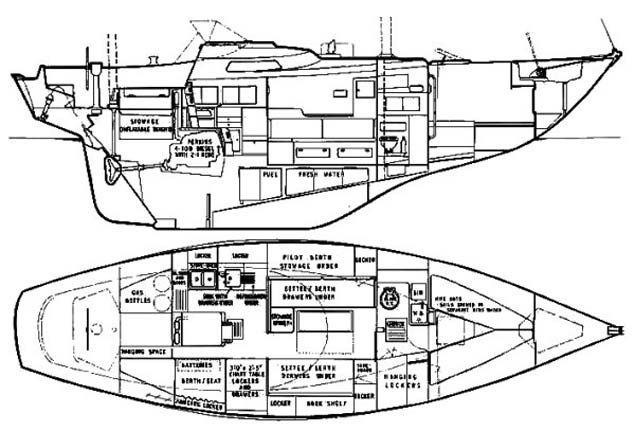 Biscay 36 hull profile. The rules of the Golden Globe Golden Jubilee Challenge stipulate that the boat is between 32 and 36ft long, and designed pre-1988 with the rudder attached to the trailing edge of the keel.
Biscay 36 hull profile. The rules of the Golden Globe Golden Jubilee Challenge stipulate that the boat is between 32 and 36ft long, and designed pre-1988 with the rudder attached to the trailing edge of the keel.
That’s “Standard Wave” measurement. Rogue waves can go much higher, and steeper ones have been recorded where ocean and land interact more directly, with our own North Atlantic serving up some world champions. But the essence of the Southern Ocean is its relentless procession of rolling giants, whose every breaking crest can be boat-breakers for the unprepared.
Yet the very fact that so many boats – relatively speaking – have now circumnavigated the world by the southern route makes this new take on the challenge irresistible, and many of those involved - including Gregor McGuckin – have been working on their campaigns since 2016 and earlier. But while the Irish sailor went at it from a standing start with little in the way of resources, and had to work an exceptionally busy Caribbean charter season and a programme of lucrative deliveries in order to build up the beginnings of a war chest, more seasoned challengers started from a position of strength.
Few were better placed than the most senior entrant, 72-year-old French long-distance racing legend Jean-Luc Van Den Heede, well-resourced to begin with, and always with new supporters available. His research quickly told him that the boat which provided optimum performance for the challenge while fitting the entry constraints of 32-36ft long, and designed pre-1988, was the British-built 1980 Holman & Pye-designed Rustler 36, of which just over a hundred were built in southwest England.
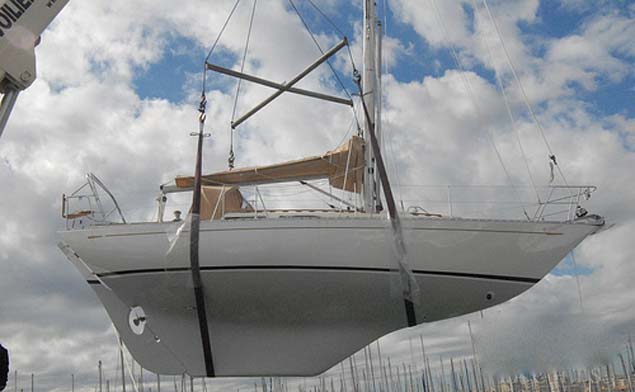 The sloop-rigged Rustler 36 – a design of 1980 – is the most-favoured boat type for the Golden Globe Golden Jubilee
The sloop-rigged Rustler 36 – a design of 1980 – is the most-favoured boat type for the Golden Globe Golden Jubilee
By 2016, Van Den Heede was in a training and tuning programme off Brittany and in the Bay of Biscay with his Rustler 36 Matmut, named for the French insurance company who are his main sponsors. His choice of boat has since been flattered by being followed by five other entries, such that the current fleet breakdown from for the July 1st start is six Rustler 36s, three Biscay 36s, two Tradewind 35s, two Endurance 35s, and one each Benello Gaia 36, Lelloe 34, Nicholson 32, QE32, and a Suhaili replica.
In terms of line honours, the Rustler 36s have to be the favourites, for although their keel/rudder/propeller aperture configuration may make them – like the Biscay 36 – something of a challenge to manoeuvre under power in a hyper-confined marina space, that is not a problem in the open ocean where their potent sloop rig and slippy hull must give them an edge over the ketch-rigged Biscay 36.
Yet such was the nostalgia for Suhaili’s achievement of 1968-69 that the original reaction to the Golden Globe Golden Jubilee challenge was the expectation that robust ketches would be the backbone of the fleet. And in any case, even a much-used Rustler 36 - seen as a “modern classic” – was beyond Gregor McGuckin’s budget, whereas he was able to find an affordable Biscay 36 – Mary Luck – in Portrush in Northern Ireland, and the show was on the road.
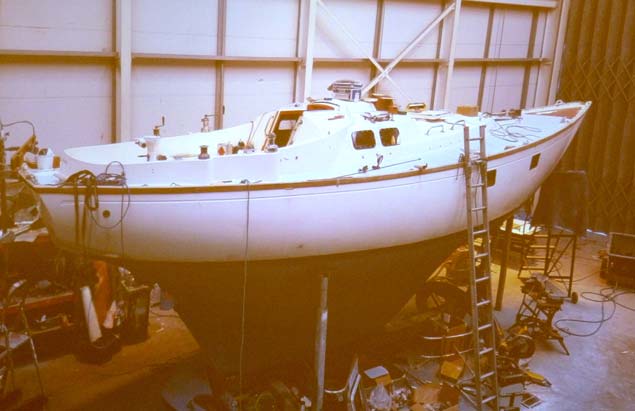 The standard Biscay 36 Mary Luck in the throes of transformation in Malahide, making her into the Golden Globe challenger Hanley Energy Endurance.
The standard Biscay 36 Mary Luck in the throes of transformation in Malahide, making her into the Golden Globe challenger Hanley Energy Endurance.
McGuckin’s own progression into high end sailing is unusual, for although he is from Dundrum in south Dublin, it was while at the College of Further Education in Coolock in the north of the city that he was introduced to sailing on the Broadmeadow Water in Malahide, and his fascination with the challenge of outdoor life was reinforced by six years of living it in Mayo before he went more seriously into fulltime sailing with the emphasis on the Caribbean, where he rose to become the skipper of a 62 footer.
Thus there’s a satisfying circularity in the fact that his newly-acquired Biscay 36 was brought back to Malahide for the very complete refurbishment and programme of modifications which are essential to have her race ready for he Golden Globe Challenge. And though she is now a boat transformed, it was still a case of work in progress on Thursday of this week as the reassuring presence of Neil O’Hagan of Team Ireland – the Enda O Coineen organisation – hosted a Gregor McGuckin reception for press and supporters alike at the National YC.
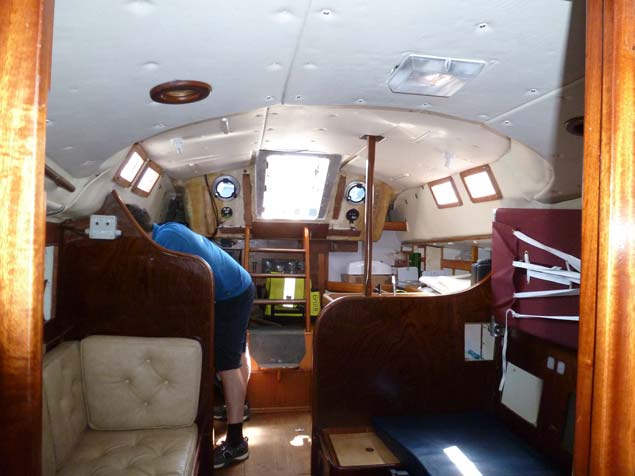 The change of use from coastal cruiser to ocean challenger, and the endless work list is evident in the saloon. Photo: W M Nixon
The change of use from coastal cruiser to ocean challenger, and the endless work list is evident in the saloon. Photo: W M Nixon
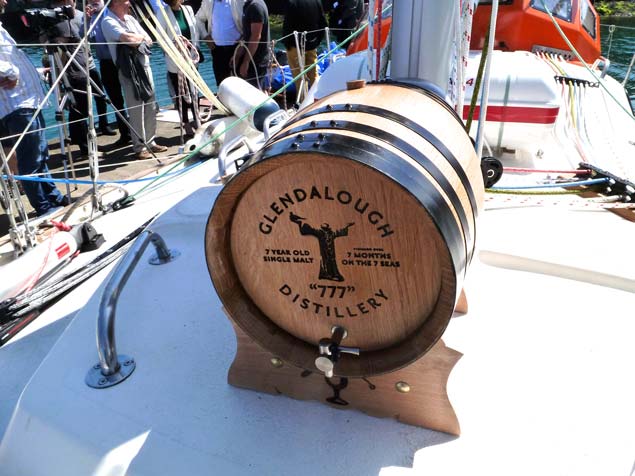 While Hanley Energy have been main sponsors since June 1st, support has been welcome wherever it can be found……Photo W M Nixon
While Hanley Energy have been main sponsors since June 1st, support has been welcome wherever it can be found……Photo W M Nixon
In a question and answer session, Gregor was in such good form that I asked him how much sleep he’d had the night before, and the answer with a smile was three hours….The jobs list keeps relentlessly increasing, while the need for increased sponsorship had always been there until lead supporters Hanley Energy came on board on June 1st. Whereas in France the concept of something like the Golden Globe Golden Jubilee – and the association with Les Sables d’Olonne – will lead to almost instant recognition from those who need to know, in Ireland you sometimes have to start completely from scratch.
That said, the work programme in Malahide attracted an increasing team of dedicated supporters and voluntary specialists – some very highly skilled indeed - with the Cruising Association of Ireland, in particular, being more than helpful. And though Hanley Energy may have been in support for a relatively short time, on the pontoon at the National YC their MD Dennis Nordon left us in no doubt of the fullness of that backing, and in all it was clear that when Gregor gets to Les Sables, there’ll be plenty of supporters on site to help him make final preparations for the start.
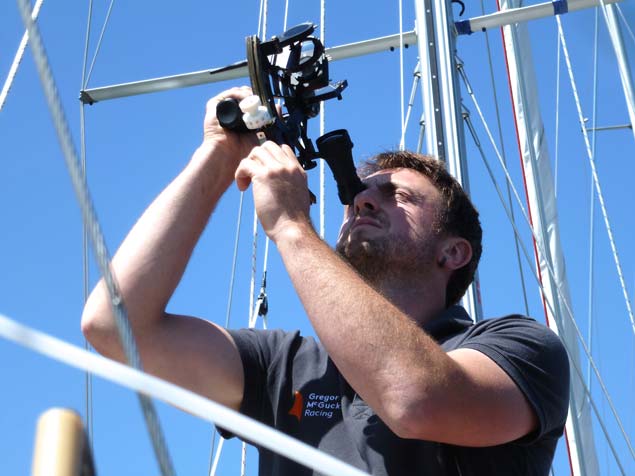 Gregor McGuckin demonstrates his skills with the sextant – all ocean navigation is to be by sextant and paper charts. Photo: W M Nixon
Gregor McGuckin demonstrates his skills with the sextant – all ocean navigation is to be by sextant and paper charts. Photo: W M Nixon
This Saturday morning, Hanley Energy Endurance is at sea, sailing south to Falmouth to join next week’s Golden Jubilee celebrations around Robin Knox-Johnston and Suhaili, for, despite the central role now played by Les Sables-d’Olonne, it was in Falmouth that Suhaili started and finished her great voyage half a century ago.
So in a decidedly crowded programme, Thursday’s gathering provided a brief opportunity for stock-taking on the changes that have taken place with the boat. This I found of special interest because way back in the previous Millennium – in 1976 to be precise – I did a sail test on one of the first production Biscay 36s for Yachting World magazine, with which I worked for a quarter of a century as a sort of freelance Columnist at Large.
 The 1975-built Biscay 36 Vizcaya at Falmouth in 1976. She is entered in the Golden Globe Golden Jubilee Challenge 2018 by Antoine Cousot of France. Photo: W M Nixon
The 1975-built Biscay 36 Vizcaya at Falmouth in 1976. She is entered in the Golden Globe Golden Jubilee Challenge 2018 by Antoine Cousot of France. Photo: W M Nixon
 Test-sailing a Biscay 36 off Falmouth, April 1976. Extra weight was later added to the ballast keel. Photo: W M Nixon
Test-sailing a Biscay 36 off Falmouth, April 1976. Extra weight was later added to the ballast keel. Photo: W M Nixon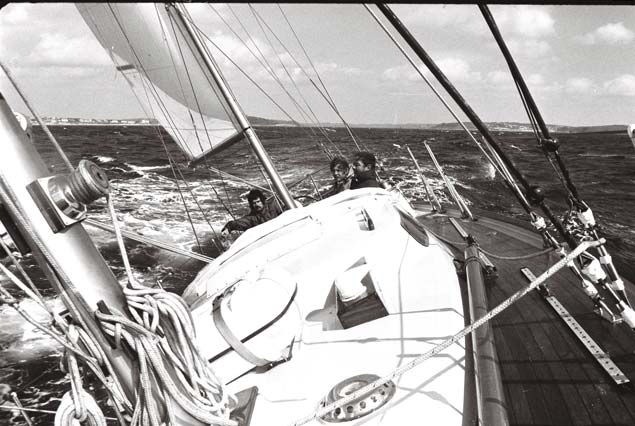 Biscay 36 on a fast reach in Falmouth Bay, April 1976. Photo: W M Nixon
Biscay 36 on a fast reach in Falmouth Bay, April 1976. Photo: W M Nixon
Most appropriately, in yet another instance of the circularity of this story, that sail test took place in Falmouth Bay. The Alan Hill-designed boats were being built by Falmouth Boat Construction Company using fibreglass mouldings by Robert Ives, and were aimed at a market seen as “people who would really like a completely wooden boat if they could only afford the maintenance”.
The test took place in a brisk but sunny April easterly with Brian Reynolds and his team from the builders. This guaranteed a congenial day’s sailing in a handsome and generally very attractive boat whose only flaw was a certain tenderness when hard on the wind, but Gregor was telling me that later models saw a significant increase in the amount of moulded-in ballast keel, which has made her stiffer.
As to the boat generally, she’d a very workable and seamanlike layout on deck and comfortable below. While a ketch rig is not everyone’s preference – particularly in a boat only 36ft long – she seemed all of a piece, the sails were easily handled, and in all she struck me as a handy vessel which was easy on the eye and a pleasure to be aboard.
 The mainmast rig in 1976 was the essence of simplicity……Photo W M Nixon
The mainmast rig in 1976 was the essence of simplicity……Photo W M Nixon …..but in 2018, the mainmast has two sets of spreaders and other extras. Photo: W M Nixon
…..but in 2018, the mainmast has two sets of spreaders and other extras. Photo: W M Nixon
But while she was well able for offshore and ocean cruises – several have crossed the Atlantic – the Southern Ocean is something else altogether, and the work programme in Malahide has seen everything from extra hull reinforcement to the upgrading of all chainplates and their bases, the re-vamp of the masts, spars and rigging, the installation of many safety features such as a massive waterproof door where formerly there would only have been sliding planks in the companionway, and the addition of a notably strong “rigid sprayhood” over the companionway.
 The new storm door in the companionway speaks volumes of the challenges which will be faced, as does the new rigid sprayhood. Photo: W M Nixon
The new storm door in the companionway speaks volumes of the challenges which will be faced, as does the new rigid sprayhood. Photo: W M Nixon
This new structure is high-vis orange, so with the new dark green hull and the remaining white deck and superstructure, we have a boat which is sailing in the colours of Ireland’s national flag. Such a thought would have been a long way from anyone’s minds in Falmouth Harbour in 1976, where the 1975-built Biscay 36 sister-ship Vizcaya lay to moorings nearby. And equally, it would have been beyond imagination in 1976 to visualise that in 2018, Vizcaya would be an entry in the Golden Globe Golden Jubilee Challenge, raced by 47-year-old Antoine Cousot of France.
 The hull has been internally reinforced forward. Photo: W M Nixon
The hull has been internally reinforced forward. Photo: W M Nixon
 Living on enthusiasm and very little sleep – Gregor McGuckin aboard Hanley Energy Endurance in Dun Laoghaire on Thursday. Photo: W M Nixon
Living on enthusiasm and very little sleep – Gregor McGuckin aboard Hanley Energy Endurance in Dun Laoghaire on Thursday. Photo: W M Nixon
Cousot’s age is not far off the average for the skippers, which makes Gregor McGuckin at 31 one of the youngest involved. And he’s facing into a challenge in which, if all goes well, he’ll be on his own for around 270 days. But as educational linkups have been arranged so that Hanley Energy Endurance’s progress can be followed by primary schools back home in Ireland, he’ll know that others are thinking of him.
Nevertheless, the challenge of a long time alone and total self-reliance is ultimately what it’s all about. But as Gregor remarked on Thursday, managing to get to a position where they really do feel alone is seen by many skippers as the first major hurdle that has to be crossed. Getting away from Les Sables-d’Olonne and out into shipping-free clear water beyond Cape Finisterre in northwest Spain is much more of a challenge for relatively slow boats like the Golden Globe contenders than it is for the flying machines in the Vendee Globe.
Whatever way it goes, the thoughts of many in Ireland will be with him. And if it goes well, he will definitely be the first Irishman to sail solo around the world non-stop.
 A Biscay 36 transformed. While Handley Energy Endurance is race number 22, dropouts mean that 18 boats are now expected to start on July 1st. Photo: W M Nixon
A Biscay 36 transformed. While Handley Energy Endurance is race number 22, dropouts mean that 18 boats are now expected to start on July 1st. Photo: W M Nixon
 It’s not every day you get your photo taken by one of the nation’s leading poets – Gregor McGuckin and Winkie Nixon as recorded by Theo Dorgan at Thursday’s Golden Globe Jubilee gathering. Photo: Theo Dorgan
It’s not every day you get your photo taken by one of the nation’s leading poets – Gregor McGuckin and Winkie Nixon as recorded by Theo Dorgan at Thursday’s Golden Globe Jubilee gathering. Photo: Theo Dorgan
Lecture: "A Voyage For Madmen"- The Golden Globe Race 1968-2018
#Lecture - "A Voyage For Madmen"- The Golden Globe Race 1968-2018 is an illustrated lecture by Gregor McGuckin which is to take place early next month on Thursday 2 February.
The talk as part of Glenua & Friends lecture programme begins at 20:00hrs in the Poolbeg Yacht & Boat Club, Ringsend, Dublin 4. There will be an entry fee of €5 in aid of the RNLI.
In 1968, nine men set out from the UK in an attempt to be the first person to sail completely alone, non-stop and without any assistance around the world. Of the nine men that left only one, Sir Robin Knox Johnston, would make it back and into the history books.
In June 2018, 50 years on from this infamous race, 30 competitors will be setting out again from the UK in an attempt to replicate this great race by sailing alone, non-stop around the world using only technology from the 1960's. This means no GPS, satellite communications, water-makers and modern light-weight materials.
Dubliner, Gregor McGuckin, will be one of those on the start line in 2018, aiming to be the first Irishman to sail solo, completely non-stop around the world. In his illustrated presentation, Gregor will tell the story of the original race and what inspired him to compete in the "retro" 2018 edition of the Golden Globe Race.
Gregor is a professional sailor who started out in the West of Ireland instructing Windsurfing and Sailing with Glenans amongst others. Since then he has become a professional delivery skipper with over 50,000 miles including several Atlantic and an Indian Ocean crossing.



























